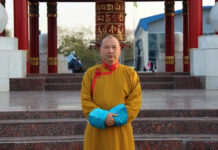
(TibetanReview.net, Dec24, 2018) – The Dalai Lama on Dec 21 addressed the inaugural event of an International Seminar on the Tipitaka / Tripitaka which was jointly organized at Bodh Gaya by the Buddhist Thai-Bharat Society, the Dalai Lama Trust and the Central Institute of Higher Tibetan Studies (CIHTS), Sarnath. The venue was the Watpa Buddhagaya, the Thai Temple complex located behind the Mahabodhi Temple. The about 500 people in the audience included saffron robed monks and lay-people dressed from head to toe in white.
The Dalai Lama spoke after a welcome address by Watpa General Secretary Dr Ratneshwar Chakma, an introductory address by Prof Geshé Ngawang Samten, Vice-Chancellor of CIHTS, the reading of a message from the Supreme Patriarch of Thailand and Watpa’s abbot Dr Phra Bhodhinandhamunee.
* * *
The message described the seminar as a result of collaboration between the Buddhist Thai-Bharat Society, the Dalai Lama Trust and CIHTS. However, he has emphasized, the inspiration for it was His Holiness the Dalai Lama who had suggested a meeting without distinguishing Theravada from Mahayana. The message called for the need to use the defence of Dhamma against weapons of destruction.
The Thai supreme patriarch likened the Mahayana to a big boat transporting many beings across the sea and Theravada to a small boat transporting beings across a river or canal while stressing the significance of their working together in mutual support. “The goal of Mahayana may be a bodhisattva, while the goal of Theravada is nirvana, but what they have in common is the goal of helping beings, of guiding humanity to the end of suffering,” he has said.
The message invoked the blessings of the Triple Gem upon His Holiness for the fulfilment of his wishes and his long life.
In his address, Watpa’s abbot recalled that while blessed Watpa monastery on Jan 26 earlier this year, His Holiness the Dalai Lama had told him over lunch that one way to spread peace and harmony would be to organize a seminar of monks from different traditions. He prayed for the Buddha’s blessing for the seminar that was underway.
* * *
The Dalai Lama opened his address by observing that Thai monks, who belong to the Pali Tradition, uphold the Theravada Vinaya, that in China there was the Dharmagupta Vinaya, and that Tibetans maintained the Mulasarvastivadin Vinaya established by the Great Abbot Shantarakshita. He noted that the differences between these traditions were slight.
He also noted that the Buddha had told the monks just before his passing away, “after I’m gone you can rely on the Pratimoksha Sutra.” He said the foundation of Buddhism was the Vinaya; that the Buddhadharma was meant for attaining liberation, to achieve which we needed to overcome our disturbing emotions. “It entails the three trainings in ethics, concentration and wisdom, of which the most important is wisdom. To really develop wisdom you need concentration and to develop concentration you need ethics.”
He continued: “The Buddhas don’t wash unwholesome deeds away with water, nor do they remove the sufferings of beings with their hands, neither do they transplant their own realization into others. It is through teaching the truth of suchness that they help beings find freedom. 2600 years ago, the Buddha placed responsibility for change on our shoulders. How did he help beings? By sharing his own experience.
“The Vinaya is the foundation of the Dharma and part of the general structure of the teachings. We also have specialized teachings, given to specific disciples, like the tantras. The Four Noble Truths are part of the general structure. Highest Yoga Tantra instructions for employing internal energies, chakras and drops were intended for certain specific disciples only.”
On Vinaya, the Buddhist rules of disciple, the Dalai Lama said the Theravada and Mulasarvastivadin traditions had different numbers of rules, but that the difference in practice was small. What was important, he said, was that “we discuss our shared practice of Vinaya, how to keep the rules and how to restore them if they are broken.”
And he continued: “The three trainings in ethics, concentration and wisdom we also have in common with non-Buddhist traditions. The difference is in how we approach wisdom. Non-Buddhist traditions in India assert an independently existent self. They also view the absorptions of the form and formless realms as more peaceful than the desire realm. Buddhism, however, teaches selflessness. Among its four schools of philosophy, the Mind Only and Middle Way Schools reject any kind of permanent, independent, single, autonomous self. This is despite it sometimes seeming that there is a self that is the ruler or controller of the five aggregates, the body-mind combination.
“The Mind Only and Middle Way Schools assert that things do not exist the way they appear. They teach selflessness not only of persons, but also of phenomena. The Mind Only School speaks of the non-duality of subject and object. They maintain that things have no external existence and arise only because of imprints on the mind. This corresponds to the quantum physics observation that nothing has any objective existence.
“The Middle Way School says nothing has any true existence, which helps combat our misconception that things exist independently. They assert that things are merely designated.”
He also pointed out that the Middle Way School says nothing has any essential identity in and of itself because things are dependently arisen.
The Dalai Lama is to give two sets of religious teachings at Bodh Gaya from Dec 24 to 31 during his current sojourn there.





